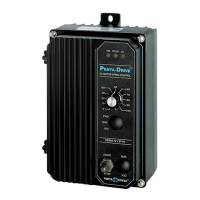operation (230 Volt AC line input with 90
Volt DC SCR rated motor or 130 Volt DC
PWM rated motor) set jumper J1 to
“90V” position. However, in step-down
operation the motor may have reduced
brush life - consult motor manufacturer.
Note: Do not connect motor armature
leads to F1 and F2 terminals. Do not
use F1 and F2 terminals for PM motors.
D. Full Voltage Field Connection (Shunt
Wound Motors Only) – Wire the motor
field leads to F1 (+) and F2 (-) terminals
of TB2 as shown in Figure 4 and Table 4.
Note: Do not connect motor armature leads to F1 and F2 terminals.
Warning! Do not use F1 and F2 termi-
nals of TB2 for any purpose other than
to power the field of a shunt wound
motor.
E. Half Voltage Field Connection (Shunt
Wound Motors Only) –
Wire the motor
field leads to F1 (+) and L1 (-) terminals
of TB2, as shown in Figure 5 and Table 4.
Note: Do not connect motor armature
leads to F1 and F2 terminals.
Warning! Do not use F1 and F2 termi-
nals of TB2 for any purpose other than
to power the field of a shunt wound
motor.
F. Remote Main Speed Potentiometer
Connection –
The control is supplied with a
prewired main speed potentiometer mounted
on the front cover. To operate the control from
a remote potentiometer (5kΩ), remove the
white, orange, and violet potentiometer leads
from P1, P2, and P3 terminals, respectively.
The leads may be taped and left inside the
control. The potentiometer assembly may be
removed if a watertight seal is used to cover
the hole in the front cover. Connect the
remote main speed potentiometer wires to
terminals P1 (low side), P2 (wiper), and P3
(high side) as shown in Figure 6.
7

